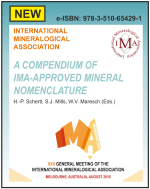
|
2013 - Nikolay V. SOBOLEV
Academician Dr. Nikolay Vladimirovich Sobolev is a Professor at the V. S. Sobolev Institute of Geology and Mineralogy of the Siberian Branch of the Russian Academy of Sciences in Novosibirsk, Russia. He follows in the footsteps of his world-famous Father, Academician Vladimir Stepanovich Sobolev, who first predicted the probability of diamonds in Yakutia (northern Siberia), as well as his three brothers, all geologists. Nick is a Full Member of the Russian Academy of Sciences, a Member of Academia Europaea and a Foreign Associate of the U.S. National Academy of Sciences.
Nick Sobolev is a world-wide distinguished scientist whose work on the petrology, mineralogy, and geochemistry of high-pressure (HP) and ultrahigh-pressure (UHP) crustal and mantle rocks, kimberlites, as well as their xenoliths and diamonds, has had a profound effect on many disciplines in Earth science. He was one of the early pioneers in the study of the morphology and composition of mineral inclusions in diamonds, with a focus on Siberian and Uralian samples, and his 1974 book on “Deep-Seated Inclusions in Kimberlites and the Problem of the Composition of the Upper Mantle” (translated into English by the Geophysical Lab in Washington, D.C. and printed by the American Geophysical Union in 1977) rapidly became not only the world-wide “Bible of Yakutian Kimberlites”, but the most thorough collection and scientific evaluation of mantle mineralogy for decades. Many of the principles in this book were only later recognized for their value in diamond exploration.
Nick Sobolev first discovered that olivine, pyroxene, garnet, and even native iron inclusions in diamonds are characterized by an imposed octahedral and cubo-octahedral diamond morphology, indicating that the inclusions formed simultaneously with the host diamonds – termed syngenetic. At the end of the 1960s and early 70s, he recognized the importance of inclusions of Cr-rich calcic and subcalcic garnets, as well as Cr-spinels, in diamonds and diamondiferous eclogites/peridotites for the genesis of diamonds; this led to the classification of mantle peridotites into lherzolites, wehrlites, harzburgites, and dunites. This provided the foundation for the current use of mineral compositions in diamond exploration and the estimation of diamond grades. These new mineralogical signature methods have been widely used in diamond exploration since the early 1970s. Indeed, the application by Sobolev and his colleagues of “mineralogical mapping techniques” has been highly successful for the Yakutian kimberlite fields, especially for the discovery of the Yubileynaya diamond mine, and contributed significantly to the discovery of the Arkhangelsk kimberlite province.
In 1976, Nick Sobolev was the first to discover the full coesite-eclogite assemblage (garnet + omphacite + coesite) in a set of mineral inclusions in Siberian diamonds. He also found an unusual enrichment of diamond-facies environments in eclogites beneath the Guayana shield (Venezuela), Argyle (Australia), and possible sources for diamond placers in the northeastern Siberian Platform and in New South Wales, Australia.
Nick Sobolev was the first to point out that diamond-bearing mantle could be inferred from significant amounts of sodium and potassium in garnet and clinopyroxene solid solutions, respectively, contained in diamonds, a signature only later picked up by others. On the basis of carbon isotope analyses of diamonds obtained with colleagues in the 1970s, Sobolev first proposed that eclogitic diamonds form from crustal carbon recycled into the mantle by subduction, and that the more abundant peridotitic diamonds formed from mantle carbon. Sobolev’s study of numerous xenoliths of diamondiferous eclogites led to the conclusion that diamond generally formed via a multi-stage process in no way linked to the formation of their host eclogites.
During the late 1980s, Nick Sobolev began an extensive study of continental eclogites in Kazakhstan. In 1990, together with V. Shatsky, he definitively proved that these rocks contained micro-diamonds. This discovery established “ultrahigh-pressure metamorphism“ (i.e., UHPM) as an entirely new field of research, confirmed by subsequent finds of similar diamondiferous eclogite terranes in Sulu/Dabie Shan, China, in Germany, in Norway, etc. The major significance of these UHP metamorphic terranes was that a major rethinking of the tectonics associated with the subduction and exhumation of oceanic and even continental crust became necessary. Further studies of the Kazakhstan locality led to important contributions on mantle metasomatic processes, in particular the role of volatiles and especially ultrapotassic fluids in diamond formation, and the significance of recycling of crustal rocks.
Nick Sobolev discovered a diamond with 53 garnet inclusions (Sobolev et al., 1998), each with different compositions that virtually span the entire range for eclogitic garnets in all of Yakutia. This find seriously addressed and questioned the then-established principle of using garnet and pyroxene inclusions from hundreds of diamonds to date the age of diamond formation.
Nick Sobolev has written several hundred peer-reviewed scientific papers on mantle mineralogy and petrology as revealed in diamonds and their mineral inclusions. He is the world’s expert in this field, and his name is synonymous with diamond inclusion research. About 20 of his publications have became classics with 100-600 citations each. As shown by the database of Thomson Reuters ISI and Google Scholar Citation, his h-index (48) and more than 8000 total citations are the highest for a Russian Earth scientist.


